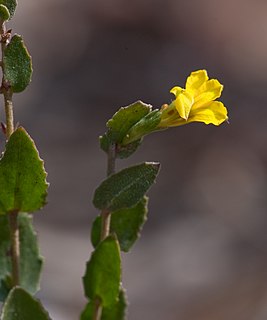
Lobelia purpurascens, commonly known as white root or purplish pratia, is a flowering plant in the family Campanulaceae of eastern Australia. It is a small herbaceous, scrambling plant with white to pale pink flowers.

Conospermum taxifolium, commonly known as variable smoke-bush, yew-leaf smoke bush or paint brush, is a plant in the family Proteaceae and is endemic to eastern Australia. It is an erect shrub with narrow elliptic to narrow egg-shaped leaves with the narrower end towards the base and panicles of cream-coloured to white, tube-shaped flowers.

Persoonia cornifolia is a plant in the family Proteaceae and is endemic to eastern Australia. It is a shrub with elliptic to egg-shaped leaves and hairy yellow flowers, and grows in northern New South Wales and south-eastern Queensland.
Dendrobium nativitatis, commonly known as the Christmas Island crimp orchid, is a species of epiphytic orchid that is endemic to Christmas Island, an Australian territory in the north-eastern Indian Ocean. It has long, straggly stems, flattened pseudobulbs, a single leathery leaf and a single pale yellow flower.

Isotoma axillaris, commonly known as rock isotome or showy isotome, is a small herbaceous perennial in the family Campanulaceae. It usually has blue or mauve star-shaped flowers from September to May. It may also be called blue star, star flower, or laurentia.

Prostanthera monticola, commonly known as Buffalo mint-bush, is a species of flowering plant in the family Lamiaceae and is endemic to higher areas of south-eastern Australia. It is a sprawling, open shrub with red, hairy branches, lance-shaped to narrow elliptic leaves and pale bluish-green to grey-green flowers with dark purple-blue veins.

Prostanthera spinosa, commonly known as spiny mintbush, is a shrub that is endemic to south-eastern Australia. It has mauve to white flowers, spiny stems and aromatic foliage.

Wahlenbergia capillaris, commonly known as tufted bluebell, is a plant in the family Campanulaceae and is native to Australia and New Guinea. It is an erect perennial herb with a few to many stems and grows to a height of 50 cm (20 in). The leaves are mostly linear with a few scattered teeth on the sides and the flowers are blue, bell-shaped with five lobes and arranged in cymes. This bluebell is widespread and common, occurring in all Australian mainland states and territories.

Bossiaea stephensonii is a species of flowering plant in the family Fabaceae and is endemic to near-coastal areas of New South Wales. It is a small, weakly erect, multi-stemmed shrub with sharply-pointed, mostly elliptic to egg-shaped leaves, and bright yellow and red flowers.

Pityrodia obliqua is a flowering plant in the mint family Lamiaceae and is endemic to the Kimberley region of Western Australia. It is an erect shrub with hairy stems, wrinkled, egg-shaped leaves and pink, bell-like flowers with purple streaks inside.
Pultenaea pauciflora, commonly known as Narrogin pea, is a species of flowering plant in the family Fabaceae and is endemic to the south-west of Western Australia. It is a dense, erect, much-branched shrub with sickle-shaped leaves with a sharp point on the tip, and uniformly yellow flowers.

Goodenia benthamiana, commonly known as small-leaf goodenia, is a species of flowering plant in the family Goodeniaceae and is endemic to south-eastern Australia. It is an aromatic undershrub with stem-clasping, egg-shaped to elliptic leaves with toothed edges, and yellow flowers arranged singly or in groups of up to three in leaf axils, with leaf-like bracteoles at the base.
Goodenia dyeri is a species of flowering plant in the family Goodeniaceae and is endemic to the south-west of Western Australia. It is an ascending herb with egg-shaped, toothed leaves at the base of the plant, with solitary yellow flowers in the leaf axils.
Hibbertia axillaris is a species of flowering plant in the family Dilleniaceae and is endemic to northern Western Australia. It is usually a multi-stemmed shrublet with ridged branchlets, foliage covered with scales and rosette-like hairs and mostly elliptic to lance-shaped leaves. The flowers are arranged singly in leaf axils, with forty-two to fifty stamens arranged around the three carpels.
Goodenia valdentata, commonly known as Davenport Range goodenia, is a species of flowering plant in the family Goodeniaceae and is endemic to a restricted area of South Australia. It is a subshrub with erect branches, coarsely-toothed, egg-shaped leaves and bright yellow flowers usually arranged singly in upper leaf axils.

Chloanthes parviflora is a species of flowering plant in the family Lamiaceae. It is a small, rounded shrub with dark green, linear leaves and mauve tubular flowers. It grows in New South Wales and Queensland.

Goodenia willisiana, commonly known as sandhill goodenia, is a species of flowering plant in the family Goodeniaceae and is endemic to drier areas of south-eastern Australia. It is an erect or ascending perennial herb with crowded elliptic to lance-shaped leaves at the base of the plant, and yellow flowers arranged singly in leaf axils.

Dampiera rosmarinifolia, commonly known as rosemary dampiera, is a flowering plant in the family Goodeniaceae.It is a perennial subshrub with linear leaves, mauve or purple flowers borne in leaf axils.
Hibbertia fractiflexa is a species of flowering plant in the family Dilleniaceae and is endemic to the Northern Territory. It is a small, multi-stemmed shrub with hairy foliage, elliptic leaves, and yellow flowers arranged in leaf axils with sixteen to twenty-two stamens arranged in groups around the two carpels.

Leucopogon attenuatus, commonly known as grey beard-heath, is a species of flowering plant in the family Ericaceae. It has grey-green leaves and small white flowers and grows in New South Wales and the Australian Capital Territory.















